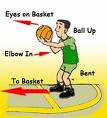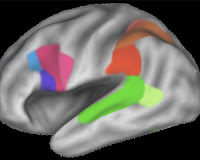However, many questions still exist as to exactly how we learn these skills. What changes happen in our brains when we teach ourselves a new task? What is the most effective and efficient way to master a skill? Do we have to be actually performing the skill to learn it, or could we just watch and learn?
Then, once we have learned a new skill and can repeat it with good consistency, why can't we perform it perfectly every time? Why can't we make every free throw, score with every shot on goal, and field each ground ball with no errors? We would expect our brain to just be able to repeat this learned motor program with the same level of accuracy.
To answer these questions, we look at two recent studies. The first, by a team at Dartmouth's Department of Psychological and Brain Sciences, led by Emily Cross, who is now a post-doc at Max Planck Institute for Cognitive and Brain Sciences in Leipzig, Germany, wanted to know if we need to physically perform a new task to learn it, or if merely observing others doing it would be enough. The "task" they chose was to learn new dance steps from a video game eerily similar to "Dance, Dance Revolution". If you (or your kids) have never seen this game, its a video game that you actually get up off the couch and participate in, kind of like the Nintendo Wii. In this game, a computer screen (or TV) shows you the dance moves and you have to imitate them on a plastic mat on the floor connected to the game. If you make the right steps, timed to the music, you score higher.
Cross and the team "taught" their subjects in three groups. The first group was able to view and practice the new routine. The second group only was allowed to watch the new routine, but not physically practice it. The third group was a control group that did not get any training at all. The subjects were later scanned using functional magnetic resonance imaging (fMRI) while they watched the same routine they had either learned (actively or passively) or not seen (the control group).
As predicted, they found that the two trained groups showed common activity in the Action Observance Network (AON) in the brain (see image above), a group of neural regions found mostly in the inferior parietal and premotor cortices of the brain (near the top of the head) responsible for motor skills and some memory functions. In other words, whether they physically practised the new steps or just watched the new steps, the same areas of the brain were activated and their performance of the new steps were significantly similar. The team put together a great video summarizing the experiment.
One of the themes from this study is that, indeed, learning a motor skill takes place in the brain. This may seem like an obvious statement, but its important to accept that the movements that our limbs make when performing a skill are controlled by the instructions provided from the brain. So, what happens when the skill breaks down? Why did the quarterback throw behind the receiver when we have seen him make that same pass accurately many times? To stay true to our theme, we have to blame the brain. It may be more logical to point to a mechanical breakdown in the player's form or body movements, but the "set-up" for those movements starts with the mental preparation performed by the brain.
In the second study, electrical engineers at Stanford University took a look at these questions to try to identify where the inconsistencies of movement start. They chose to focus on the "mental preparation" stage which occurs just before the actual movement. During this stage, the brain plans the coordination and goal for the movement prior to initiating it. The team designed a test where monkeys would reach for a green dot or a red dot. If green, they were trained to reach slowly for the dot; if red, to reach quickly. By monitoring the areas of the monkeys' brains through fMRI, they observed activity in the AON prior to the move and during the move. Over repeated trials, changes in reach speed were associated with changes in pre-movement activity. So, instead of perfectly consistent reach times by the monkeys, they saw variation, like we might see when trying to throw strikes with a baseball many times in a row. Their conclusion was that this planning activity in the brain does have an effect on the outcome of the activity. Previously, research had focused only on breakdowns during the actual move and in the mechanics of muscles. This study shows that the origin of the error may start earlier.
As electrical engineering Assistant Professor Krishna Shenoy stated, "the main reason you can't move the same way each and every time, such as swinging a golf club, is that your brain can't plan the swing the same way each time." Postdoctoral researcher and co-author Mark Churchland added, "The nervous system was not designed to do the same thing over and over again. The nervous system was designed to be flexible. You typically find yourself doing things you've never done before." The Stanford team also has made a nice short video synopsis of their study.
Does practice make perfect? First, we must define "practice". We saw that it could be either active or passive. Second, we know sports skills are never "perfect" all the time, and need to understand where the error starts before we can begin to fix it.
Cross, E.S., Kraemer, D.J., Hamilton, A.F., Kelley, W.M., Grafton, S.T. (2008). Sensitivity of the Action Observation Network to Physical and Observational Learning. Cerebral Cortex DOI: 10.1093/cercor/bhn083
CHURCHLAND, M., AFSHAR, A., SHENOY, K. (2006). A Central Source of Movement Variability. Neuron, 52(6), 1085-1096. DOI: 10.1016/j.neuron.2006.10.034






Comments